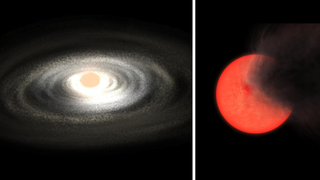
(left) an illustration of a screaming newborn star (right) an artist’s interptation of a anceint ‘old smoker’ star
(Image credit: Royal Astronomical Society)
Astronomers have uncovered a huge haul of hidden stars, including some violently erupting newborn protostars as well as others that fall under an unexpected new category of ancient giant red stars. They dub the latter bodies “old smokers.”
These old smokers lurk at the heart of the Milky Way, the team says, sitting quietly for decades and fading away until they eventually puff out vast clouds of smoke. The stars were discovered through a 10-year survey of the sky conducted with the Visible and Infrared Survey Telescope (VISTA), located high in the Chilean Andes at the Cerro Paranal Observatory. This effort managed to track almost 1 billion stars.
The same investigation, known as the VISTA Variables in the Via Lactea (VVV), also uncovered dozens of erupting protostars as the international team behind the study looked closely at 222 stars.
“About two-thirds of the stars were easy to classify as well-understood events of various types,” Phillip Lucas, team leader and a professor at the University of Hertfordshire, said in a statement. “The rest were a bit more difficult, so we used the Very Large Telescope (VLT) to get spectra of many of them individually. A spectrum shows us how much light we can see at a spread of different wavelengths, giving a much clearer idea of what we are looking at.”
Related: An ‘extragalactic’ intruder may lurk among stars orbiting the Milky Way’s black hole
The stars spotted by the team had remained hidden due to the vast amounts of gas and dust that block our view of the Milky Way’s heart.
This material is very effective at absorbing visible light — but less adept at absorbing and blocking infrared wavelengths of electromagnetic radiation. What that means is VISTA, with its infrared eye on the cosmos, was in fact able to peer through those clouds of gas and dust to uncover unseen stars close to the center of the Milky Way.
“Our main aim was to find rarely-seen newborn stars, also called protostars, while they are undergoing a great outburst that can last for months, years, or even decades,” Zhen Guo, team member and a scientist at the University of Valparaiso, said in the statement.
Protostars in young star systems undergo these extreme outbursts as they gather enough mass from their natal envelopes of gas to trigger the fusion of hydrogen to helium and become fully-fledged stars, a process that the team hoped to learn more about.
“These outbursts happen in the slowly spinning disc of matter that is forming a new solar system. They help the newborn star in the middle to grow, but make it harder for planets to form,” Guo said. “We don’t yet understand why the discs become unstable like this.”

A new born star erupts in a cloud of gas and dust brightening over 2 years until 2015 and remianing bright until at least 2018 (Image credit: Royal Astronomical Society)
The astronomers say they spotted 32 “screaming” stellar infants, which experienced brightness increases between 40 and 300 times their usual luminosity.
In the case of many of these protostars, the explosive events that triggered such increases in brightness are actually still happening, allowing the team to investigate how these eruptions evolve over time as they increase in brightness, reach a peak luminosity, then fade away.
While this is what the astronomers were hunting with VISTA, their study concerning the heart of our galaxy also turned up something completely unexpected: a hitherto unknown type of star at the other end of the stellar life cycle.
Where do the ‘old smoker’ stars hang out?
The VVV team discovered 21 red stars at the center of the Milky Way, which showed changes in brightness over several years that were difficult to explain.
“We weren’t sure if these stars were protostars starting an eruption, or recovering from a dip in brightness caused by a disc or shell of dust in front of the star – or if they were older giant stars throwing off matter in the late stages of their life,” Lucas said.
The team used light spectra from 7 of these stars to eventually determine that they represent an entirely new type of giant red star that sat quietly for decades before suddenly and unexpectedly spitting out clouds of smoke, hence the name “old smokers.”

Infrared images of a red giant star or “old smoker” about 30,000 light years away, near the center of our Milky Way galaxy, that faded away and then reappeared over the course of several years. (Image credit: Royal Astronomical Society)
The old smokers are heavily concentrated in the innermost region of the Milky Way’s heart, known as the nuclear disk, where stars tend to have much greater concentrations of elements heavier than hydrogen and helium. Astronomers call those heavier elements “metals.”
While the greater concentration of metals in these stars should help dust condense more easily from their outer layers of superheated gas, or plasma, quite how this leads to them puffing out smoke remains currently unknown.
The team thinks that solving this puzzle could help better determine how elements forged by stars are distributed throughout the cosmos, as well as how they eventually become the building blocks of the next generation of stars and planets.
“Matter ejected from old stars plays a key role in the life cycle of the elements, helping to form the next generation of stars and planets,” Lucas said. “This was thought to occur mainly in a well-studied type of star called a Mira variable.
“However, the discovery of a new type of star that throws off matter could have wider significance for the spread of heavy elements in the nuclear disc and metal-rich regions of other galaxies.”
The team’s research was published on Friday, Jan. 26 across two papers in the journal Monthly Notices of the Royal Astronomical Society.
Join our Space Forums to keep talking space on the latest missions, night sky and more! And if you have a news tip, correction or comment, let us know at: [email protected].
Breaking space news, the latest updates on rocket launches, skywatching events and more!
Robert Lea is a science journalist in the U.K. whose articles have been published in Physics World, New Scientist, Astronomy Magazine, All About Space, Newsweek and ZME Science. He also writes about science communication for Elsevier and the European Journal of Physics. Rob holds a bachelor of science degree in physics and astronomy from the U.K.’s Open University. Follow him on Twitter @sciencef1rst.
>>> Read full article>>>
Copyright for syndicated content belongs to the linked Source : Space.com – https://www.space.com/milky-way-hidden-stars-old-smokers-erupting-protostars













![[News] Japan Develops 10nm Nanoimprint Technology, with Potential to Tackle EUV Bottleneck – TrendForce](https://earth-news.info/wp-content/uploads/2025/12/329851-news-japan-develops-10nm-nanoimprint-technology-with-potential-to-tackle-euv-bottleneck-trendforce-360x180.jpg)














![[News] Japan Develops 10nm Nanoimprint Technology, with Potential to Tackle EUV Bottleneck – TrendForce](https://earth-news.info/wp-content/uploads/2025/12/329851-news-japan-develops-10nm-nanoimprint-technology-with-potential-to-tackle-euv-bottleneck-trendforce-120x86.jpg)

